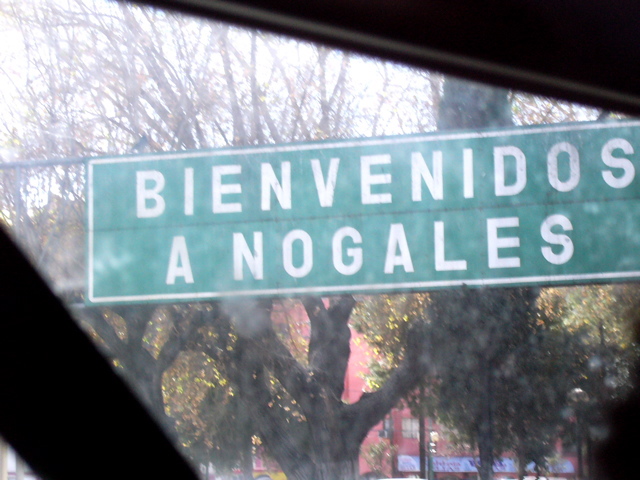|
|
|
Making A Run For The Border
With Phoenix, Arizona a short 4 hour drive to the frontier with Mexico, this 34 year old native is appalled by the chasm between the popular discourse about migration here in this state versus the stark ramifications of what living just south of that line in the sand can mean to a person. Before taking this class I was in favor of honoring that line in the sand and for closing the door to migrants completely. Why? Because Iím an environmentalist who grew up in this state, whose population has increased by 300% since the time I was born, whose waves of migrants to this state is alarming to me. In the next 30 years the population of Arizona is expected to be nearing 12 million people! Thatís over twice as many people as today (Statisical Abstract, 1999). How will this tax our natural environment and affect the quality of life for everybody thatís here? Closed borders are not the answer and Iíll start with telling you why my opinion has changed. Next Iíll discuss how there are students, teachers, activistís, Samaritans and government agents who are all making a difference to others lives and inspire us all. All of us would suffer from a closed, militarized border. How else would you fill in all the gaps in our porous southern frontier other that using the intimidation of U.S. border forces? Because of the Borderlinks trip and related readings, I now possess a working definition of a free trade zone: an area where cash, goods, and a workforce can move without restriction. If any one of those three items is not met then you donít have a free trade zone. Without allowing people to move to where the jobs are you distort the effects of a free trade zone and open opportunities to exploit existing disparities between the cost of the workforces of America and Mexico (and Central America). A cheap workforce is not all that Mexico has to offer of course; it also doubles as a great illegal dumping ground for toxic substances born on both sides of the line! I wish I was kidding. According to Reed (2002) if most of the waste in Mexico cannot be tracked by enforcement agencies, it is not in a companyís best interest to account for it through [voluntary] auditing procedures and then be obligated to manage it. Without government resources to enforce environmental rules Mexico becomes a cheap dumping ground for hazardous waste. Thatís too close to me (us) because we all know pollution just doesnít stay where it is supposed to. How is having toxic, illegal, and immoral dumps, where it is likely that there was no attempt to recycle or dispose of the waste properly, just a few hours away from here, be better than having migrants here because jobs lured them, even if Arizonaís natural resources are strained? It isnít. Illegal dumping of waste lines the pockets of corporate executives and investors here at home, but aside from that itís another reason why people south the border would want to migrate! Last I want to reflect on the inspirational people that I encountered as a part of this field trip. There were many but I will give you and example of two. The first is Joseph Stiglitz who called it like he saw it and as chief economist at the World Bank his voice is one that will get heard by some of those who need to hear it. Stiglitz argues that many of the complaints voiced by protesters in recent years- that IMF structural adjustment programs have caused widespread suffering; that free trade agreements mainly benefit the rich; that privatization has proved disastrous in many countries-have a solid basis in fact (Eyel, 2002). Tenacity and level-headedness such as his can change the world. Similarly, grassroots activistís like Francisco ďKikkoĒ Trujillo, was equally able to use his position, intellect, and heart to make a difference at home in Nogales, Mexico. As a former Maquiladora manager he has an intimate understanding of the effect free trade has had on his city and country. As Borderlinks director he is making a difference by educating the public about whatís really going on at the border. Both men are great examples of overcoming adversity and making the choice to try to make the future brighter, not just for themselves, but for everyone else too. Arizona will reach 12 million people by 2030 which may seem overwhelming yet other metro areas such as Los Angeles has handled population growth such as this while actively pursuing initiatives that will cleanup their environment and protect the surrounding natural areas. We can manage this growth mainly because of massive engineering projects in the 20th century that provided the infrastructure for people to move into this otherwise forbidding place. Mexico does not have this infrastructure and Nogales is now a city of 400,000 residents! Is our border neighbor Mexico headed for environmental catastrophe which would naturally be a strain here at home? Not with defenders like Stiglitz and Trujillo around. Reference List Eyal, J. , (2002). Rebel with a Cause: The Re-Education of Joseph Stiglitz. The Nation, 6/10/2002. Reed, C., (1998). Hazardous Waste Management on the Border: Problems with Pratices and Oversight Continue. Borderlines, Vol. 6, No. 5, July 1998. Statistical Abstract of the United States, (1999). Retrieved February 25, 2006, from http://www.census.gov/prod/99pubs/99statab/sec01.pdf). |
|

